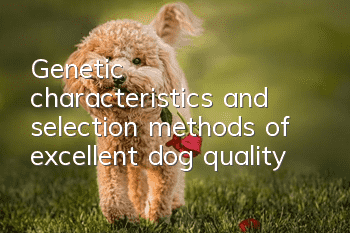Genetic characteristics and selection methods of excellent dog quality

The quality of a dog is determined by various behavioral traits and can be inherited. The heritability of different quality traits is different. Therefore, in the process of breeding dogs with excellent quality, scientific selection should be carried out based on the genetic characteristics of each trait, combined with the environmental conditions and training requirements of various places, so as to select breeding dogs with multiple excellent qualities and high comprehensive level as much as possible. .
1. body shape. Dog size is a quantitative trait and generally has high heritability. Research shows that the heritability of dog body size is 0.35~0.65. For example, the body size of a German Shepherd at 60 days of age has a heritability of 0.45. Therefore, large improvements in dog body size can be achieved using individual phenotypic selection. In practice, breeding dogs of corresponding sizes should be selected according to the different uses of the dog.
2. sense of smell. The sense of smell is a very important trait for dogs' work. Generally, dogs have a sense of smell that is thousands to tens of thousands more sensitive than humans. However, there are great differences between different breeds and dogs of the same breed and in different litters. This is because the sensitivity of a dog's sense of smell is hereditary. The dog's sense of smell is a quantitative trait, controlled by small-effect polygenes and affected by environmental factors. Its heritability is 0.12~0.20. Therefore, the selection of smell trait, like other heritability traits, should not be conducted through individual selection. Since smell is less relevant to training, pedigree selection should be used. Specifically, when selecting breeds, the average level of the littermates (siblings) should be considered, and outstanding individuals should be selected for breeding among dogs with a higher average level.
3. Desire for title. Prey behavior in dogs is an innate instinct. However, due to genetic reasons, there are also some dogs that are unique or have a low desire to hold. The study found that the heritability of picking and prey behaviors in German Shepherds at 8 weeks of age was 0.415 and 0.35 respectively. Actual breeding has also proved that the two traits of dog bite and prey have moderate heritability and can be improved through individual phenotypic selection. Experiments show that male and female dogs have a high desire to pick, and the passing rate of their offspring (average of three litters) reaches more than 80%, while male and female dogs have a low desire to pick, and the passing rate of their offspring is less than 20%. , the non-title rate reaches more than 25%. Therefore, in order to improve the fetching excitement of the entire dog group, it is necessary to select breeders or participate in breeding. In particular, male breeding dogs must have a strong desire to possess objects, a high desire to pick them up, and a long-lasting hold.
4. courage. Courage is a relatively general trait that includes many things, such as not being afraid of gunfire, strangers, fire, and new environments. The data obtained for estimating the heritability of courage are inconsistent and vary widely, and there is currently no authoritative value. However, practice has proven that courage is highly correlated with training and has medium to low heritability. The measured values of courage at 6 months and 12 months are highly correlated (p<0.05). Among them, fear of gunshots is a trait The correlation coefficient is 0.39 (p<0.05). It can be seen that the selection of courage is more accurate after 6 months of age. Therefore, when choosing a breeding dog, you must choose a dog with courage that is appropriate.adaptable individuals and strengthen relevant training.
5. Aggression. There is a clear direct proportional relationship between dog aggression and training. However, it has been proven that dog aggression is hereditary. For example, the heritability of German Shepherd aggression is about 0.2, and it is related to a higher degree of courage phenotype, which can be improved through selection. Therefore, a bold and aggressive dog must be selected as a breeding dog. Of course, dog aggression varies by breed and gender. After long-term selection, some dogs have basically lost their aggressiveness, such as Labradors, Pekingese dogs, etc. Male dogs are more aggressive than female dogs.
6. Excitement and flexibility. Both excitability and agility in dogs are heritable, with moderate heritability. Practice has proven that breeding dogs have high levels of excitement and flexibility, and their offspring have high levels of excitement and flexibility. During the 6-month-old assessment, 84% of the dogs were excitable and lively, while only 24.5% of the offspring bred from breeding dogs with low excitability and poor flexibility could meet the training requirements. Therefore, individuals who are not excited and flexible cannot breed. In particular, male breeding dogs must be highly excited, long-lasting, and flexible in transition.
7. Other traits. In addition to the above-mentioned main traits, there are also behavioral traits related to training use such as obedience, hearing, and ease of training. These traits are heritable. For example, the heritability of hearing of American guide dogs is 0.25, the heritability of trainability is 0.12, and the heritability of dog obedience is about 0.20. Therefore, during seed selection and breeding work, attention must be paid to the selection and improvement of these traits.
8. The selection and breeding of dogs with high food quality must be based on breed selection and completed through selection and matching. In this case, a comprehensive evaluation should be carried out based on the genetic characteristics of various quality traits, the individual performance of the dog, combined with its pedigree, descendants, siblings and other information, and a comprehensive and systematic comparison should be made based on actual needs and possibilities. Select excellent breeding dogs, and then use scientific selection methods according to the selection principles to breed a large number of excellent working dogs. For example, use breed dogs that are ferocious and tenacious, have a keen sense of smell, and have good endurance for homogeneous mating, breed riot-proof, long-lasting, smaller, less aggressive male and female dogs, and breed drug and explosive search dogs. Another example is to use dogs with good physical appearance and average neurological type to cross-breed with dogs with average physical appearance and good neurological type to breed working dogs with better appearance and neurological type.
- Four tips to correct your dog’s barking habit
- Precautions for bathing long-haired dogs
- What are the causes of dog infertility?
- How to take care of your dog’s ears daily
- Do all dog owners know the common sense about a dog’s menstrual period?
- How much does a Corgi cost and is it easy to raise? Corgi pictures | price | training
- How to prevent skin diseases in golden retrievers
- The dog keeps scratching himself but there is nothing on him
- How to train a Teddy not to bite? You can learn it in three minutes!
- Dog teeth need to be cleaned regularly



